- What John Lennon Thinks of Donald Trump - November 14, 2016
- The Meaning of Fun: The Paul is Dead Rumor - February 3, 2016
- BEATLES-STREEP-SHEA SHOCKER: IT’S NOT HER!!!! - August 13, 2015
Beatles vs. Stones
by John McMillian
288 pp.
Simon & Schuster, 2013
Reviewed by Devin McKinney
A character in Jonathan Lethem’s novel The Fortress of Solitude claims that every small-group dynamic found in fiction or in life is comprehensible via the Beatles model of organizational relationships: “The Beatles thing is an archetype, it’s like the basic human formation. Everything naturally forms into a Beatles, people can’t help it.” He illustrates this theory by applying it, convincingly, to Star Wars and The Tonight Show. (For the record, the archetypal roles—or “four sides of the circle,” as the title of a Beatles bootleg once had it—are said to be those of the responsible-parent, the genius-parent, the genius-child, and the clown-child.)
It is a longstanding tendency of Beatles fans to feel, in this or some similar way, that their favorites encompass the whole of humanity—every personality type, psychological disposition, emotional style. Fans of the Rolling Stones have never fostered any such fancy. The Jagger-Richards domination was, almost from the beginning, so strong that the band’s geometric equivalent, rather than a circle with four sides, might resemble two rhombi connected by crescents to a string of three shapes (Jones-Taylor-Wood heptagon, Wyman trapezoid, Watts kite) trailing behind like an essential but subordinate tail. A self-completing solid of arcs and edges versus a stylized scorpion: That, in one formulation, is Beatles vs. Stones. It is about the only contrast between the groups not tracked by John McMillian in his book of that title. The two groups, he writes, “represent two sides of one of the twentieth century’s greatest aesthetic debates,” one with inkblot meaning for each individual: Which you prefer is “thought to reveal something substantial about [your] personality, judgment, or temperament.”
In a succinct introduction, McMillian enumerates the standard polarities assumed to separate the groups: “The Beatles may be described as Apollonian, the Stones as Dionysian; the Beatles pop, the Stones rock; the Beatles erudite, the Stones visceral; the Beatles utopian, the Stones realistic.” But McMillian—whose previous book was the excellent Smoking Typewriters: The Sixties Underground Press and the Rise of Alternative Media in America (2011)—acknowledges that none of these traits are categorical, that each stereotype is complicated by contradiction and overlap. He takes a similar view of the processes by which the bands took up opposing positions in the popular mind, arguing that while it was in some measure an expedient media creation fed throughout the ‘60s by fan bias, it also has a natural grounding in the competitive proximity of two gifted, ambitious collectives occupying much of the same musical and geographical space:
It is sometimes said that the “rivalry” between the Beatles and the Stones was just a myth, concocted by sensationalizing journalists and naïve teenyboppers. In reality, we are told[,] the two groups were always friendly, admiring, and supportive of each other. It is doubtful, however, that their relations were ever so cozy or uncomplicated. The two groups clearly struck up a rapport, but that never stopped them from trying to outperform each other wherever and however they could. And as most people understand, emulous competition rarely nourishes a friendship; more often it breeds anxiety, suspicion, and envy.
McMillian means to disturb the “conventional wisdom” around the Beatles-Stones duality, but purely as a means of arriving at a greater historical clarity. He has no personal case to argue for or against either band: “In this dual biography, I’ve merely juxtaposed the Beatles and the Stones, examined their interrelations, and shown how their rivalry was constructed.” Though he admits to a preference, McMillian does not reveal it. That is not only fair, given that he writes as a historian and not a critic, but also wise: Had he revealed his own preference even at the very end, it might have cast a pall of partiality over the proceedings.
***
The Beatles’ and the Stones’ trajectories through the 1960s were hardly parallel lines, but they were common paths. Both were English groups influenced by American styles; both sought stardom in the US as the ultimate and essential peak of success; both held dominion over the London pop scene at its apex of influence; both were embroiled in the drug and revolution wars of the late ‘60s; both were natural counterparts in larger debates about pop and rock, rebellion and concession, authenticity and contrivance, rockers and teenyboppers. McMillian details the processes by which the Beatles (raised on Liverpool streets of moderate-to-extreme roughness and baptized in the pits of Hamburg clubland) and the Stones (chip-on-shoulder types from middle-class London suburbs who opted for the fringe and filth of bohemian living) came to their precipices of success, and by which their respective managers, Epstein and Oldham, fashioned them in images nearly the exact opposite of their apprentice-level selves.
In one sense at least, the Beatles may be seen as a priori more “authentic” than the Stones: They hit the music scene first, and so were the defining influence. As has been well known for many years, Oldham modeled his Stones to be the anti-Beatles. In the words of journalist Chris Hutchins, “Brian [Epstein] left the way open for the Stones to occupy a very large vacancy”; or as Greil Marcus wrote, “It was the Beatles who opened up the turf the Stones took as their own—there was no possibility of a Left until the Beatles created the Center.” Likewise, the Stones’ incorporation of the Beatles’ musical influence was often so blatant as to appear less absorption than appropriation (“Yesterday,” a string ballad, was followed by “As Tears Go By,” ditto; the sitarized “Norwegian Wood” was echoed by “Paint It Black”; Pepper was parodied, or imitated, or something, by Satanic Majesties).
But it would be foolish to claim that because the Stones’ musical influence on the Beatles was not so obvious, it was less profound. Influence takes different forms, and one is the imperceptible stress of competition. There can be no doubt that the Beatles’ necks registered the Stones’ hot breath just as keenly as Dylan’s, the Beach Boys’, or the Motown wizards’. If the Beatles were to stay ahead, they needed a competitive entity like the Stones—also a band, also English, with a hunger for novelty similar to their own—to stay ahead of. McMillian is quite good at tracking this tension, and at keeping it alive for the reader. His book reads fast, as if self-propelling. He doesn’t linger too long on one episode before taking up the next.
***
And there is always a next. The London fashion photographer David Bailey, who took some of the best contemporary shots of both groups, is quoted, “I thought of the Beatles as a boy band, a very manufactured group when they started out,” whereas “the Stones seemed to grow organically”—which demonstrates handily the pitfalls of mistaking image for reality, as well as how little the common cant about “authenticity” has to do with good music. The standard benediction on the Stones, and concomitant knock on the Beatles, has always been that there was something somehow realer about the Stones; that their combination of black influence, rebel stance, sexual display, drug hipness, and wild musical style constituted an identity not calculated or patched together but, as Bailey says, “organic.” Who can say why that is—except to suggest that that image confirms an image that confirms the observer to himself? Or that that image is one that regards broad popular acceptance, particularly among grownups and females, as illegitimate? Or that there is a deep male narcissism, often indulged by women, coiled at the center of that image?
McMillian cannily relates this orthodoxy of the organic to what we call rockism, “a particular kind of snobbery [which] privileges feelings over technique, and emotion over craft,” and which in the ‘60s, long before it was named, led blues purists and proto-rockists to scorn “pop’s lumpen love of the Beatles.” He also quotes a key insight from Phil May, lead singer of the London blues-rock band the Pretty Things, contemporaries and, in their first incarnation, near-slavish imitators of the Stones. At Stones shows, May recalls, male libido and male prerogative were excited, where they’d been stifled or dulled by earlier pop shows, which most boys attended at the behest of their dates and disdained as girly affairs. But come the mid-‘60s and the Stones’ particular type of “organic” badassery, “the chicks were pushed further and further back because they were physically overwhelmed.” By the late ‘60s, the audience at a Stones concert is predominantly male. By the ‘70s and ‘80s, it is overwhelmingly so—as are the audiences for hard rock, heavy metal, and progressive rock. Here we are at the heart of the male-female, rock-pop, fanboy-teenybopper dynamic—and the Beatles-versus-Stones debate. McMillian is well aware of this, but he could have gone further down this road, a road that forked at a certain point, with the mass audience, the bisexual audience—the Beatles’ audience—staying on the main road while the fan-boys carved out their cults elsewhere.
***
“The Stones were the cool group,” McMillian writes, “because they valorized youth in ways that the Beatles did not.” Valorized youth to itself, that is—which may be one reason why the Stones are perhaps not as good a group as the Beatles to grow old with: in valorizing youth they flattered it, making a fetish of youthful attitudes like disdain, diabolism, and cruel sexuality. (All exotic spices in the goulash of art and life, but simply not as enticing after a certain point of maturity.) The Stones were, however, sometimes seen as a better group to be young with—especially in the anti-establishment atmosphere of America in 1968. McMillian builds on his previous book’s richly detailed history of the underground press with an authoritative composite of that press’s response to the “Revolution”-“Street Fighting Man” kerfuffle. He is not the first to tell this tale: Jon Weiner’s Come Together: John Lennon In His Time (1984) laid the foundational narrative; a long passage in my own Magic Circles: The Beatles In Dream and History (2003) was devoted to the debate; and music professor John Platoff’s interesting scholarly paper “John Lennon, ‘Revolution,’ and the Politics of Musical Reception” appeared in the Journal of Musicology in 2005. But McMillian draws on archives of the underground press that were uncollected or inaccessible until more recently. He retrieves livid passages from agit-prop broadsheets and radical rags like the San Diego Door and Space City! to limn a fuller picture than we’ve previously had of just how the groups’ differing responses to street revolt went down with the radical audience. In a fascinating and probably unrepeatable display of rock dialectics, John Lennon spends most of 1968 (and beyond!) trying, like an aggrieved virgin, to decide if he will or he won’t; and Mick Jagger, flush with the underground approval that greeted the anti-utopian “Street Fighting Man” and Beggars Banquet, goes from revolutionary hero to “half-assed male chauvinist prick” (as one underground editorialist called him) in little more than a year.
Beatles and Stones in ‘68 is a locus classicus of rock and politics in full flaming collision. Both bands have continued to weather criticism for the positions they took in the late ‘60s, or didn’t take, or seemed to take and then take back; their fans and detractors, explicators and users are likewise eternally vulnerable to the revisionist’s scold. McMillian, historian-not-critic, declines to pass judgment—and good for him, because many of the rest of us have. We know how the Beatles, the Stones, their fans, and their critics should or should not have reacted to everything in their world back then. We can plainly see where musicians and audience were visionary and where they were shortsighted. Retroactively, we can topple any stance, justify any equivocation, or vice versa. What we can’t so easily do is see the Beatles and Stones as human beings, and admit that yes, they were passionate—but mainly about their music, not about politics or pushing society in a better direction, except insofar as those were incidental to the music; that they were, as much as they were anything, young and fashion-conscious; that they were not particularly farsighted, analytical, or politically informed; that they were innovators within a status quo of which they were uniquely successful products. It was not in the nature or ability of the Beatles or Stones to be revolutionaries, or to respond presciently to the exploding components of a world that at the flashpoints of 1967-69 demanded nothing so much from them as the “proper” allegiance—be that to the establishment, or to the revolution, or to their art, or to the future. Even less could they begin to imagine the rampant revisions of future analysts like ourselves, we who fault or praise them according to our personal preferences and from our elevated vantage—this moment in time where we, like everyone before us, imagine we can see for miles in every direction, but are in fact only looking back from somewhere a bit further down the same long, long road.
***
I spot very few mistakes in Beatles vs. Stones, and those are minor—though there’s one inaccurate lyric, and McMillian leads into his discussion of “Street Fighting Man” having forgotten to identify the song. His style is not particularly vivid, but it is smart, and his pages flow, even past the occasional crag of cliché (“a limousine whisked [them] away”; the Beatles were “generational pied pipers”). Having cautioned us that he is not a critic, McMillian proves it in the few passages of musical or lyrical analysis, which send the reader’s eyes skipping stone-like over the smooth surface of things that have been said before. He has a tendency now and again to let the descriptive line go slack: “[They] kept going into these long, intentionally sloppy improvisational blues jams… Oldham was so oblivious that he didn’t even realize he was getting punked.” That’s lazy, colorless, first-draft writing, easily mistaken for an interview quote from someone who’s not a writer.
Beatles vs. Stones concludes with an “Epilogue,” and the epilogue ends with brutal finality—a short paragraph on John Lennon’s assassination. The logic of ending this book this way is not difficult to make out, or to work out, but it is a bad miscalculation. It doesn’t ring, rouse, resonate, or resound. It does nothing. McMillian slams a door, cuts off a conversation, and the voices and lingerings of “one of the twentieth century’s greatest aesthetic debates” all blow away as ash in a quick wind. No, I cry out, now is the moment for the author to step up, not to vanish. Culmination is called for. I’m a sucker for culmination—for end statements that are both totalizing and cryptic, poetic and tangible, that encompass theme and event in a unified field of meaning while leaving wide and undeclared the vista that spreads beyond the book. Is that too much to ask? Perhaps the components of a wrap-up are scattered throughout the earlier chapters; perhaps McMillian could give me what I want simply by cutting and pasting a few passages into a different order. Will he do that in a future edition? Probably not. The ending remains abrupt, alienating, an emptiness diminishing all before it.
***
The majority of the “Epilogue” is given, in fact, to a takedown of the Stones post-Exile. It’s undeniable that, from one perspective, the worst thing they ever did for themselves was to not break up at the right time. McMillian recounts the Stones’ accumulation through the 1970s, ‘80s, ‘90s, aughts, and ‘teens of megatours, corporate sponsorships, time-wasting albums, coin-snatching compilations, obscene ticket prices, and licensed crap affordable and desirable only to those fanboy-jock executive millionaires who literally have so much money they don’t know what to do with it. Yet again, we find it is impossible to survey the results of the Stones’ commercial elephantiasis and not come away damning the deadly sin of avarice—the band for promoting it, ourselves for ever having fed it. And yet again, we’re reminded of the classic line Nik Cohn wrote far back in 1968, in Rock from the Beginning, to end his chapter on the Stones, whom he loved: “And if they have any sense of neatness, they’ll get themselves killed in an air crash, three days before their thirtieth birthdays.”
Did anyone ever write anything similar about the Beatles? Would it have occurred to them? Or did the Beatles guarantee themselves a longer life in sound, memory, the collective daydream not simply by having the sense to break up before they fell apart, but also by landing on the world stage less beholden than the Stones to purist or rockist claims of authenticity; to someone else’s rebel yell; to the proprietary pulse of the penis? Perhaps it’s upon questions like these—and one’s personal response to them—that the Beatles-vs.-Stones debate tilts, and is finally won. By the Beatles.


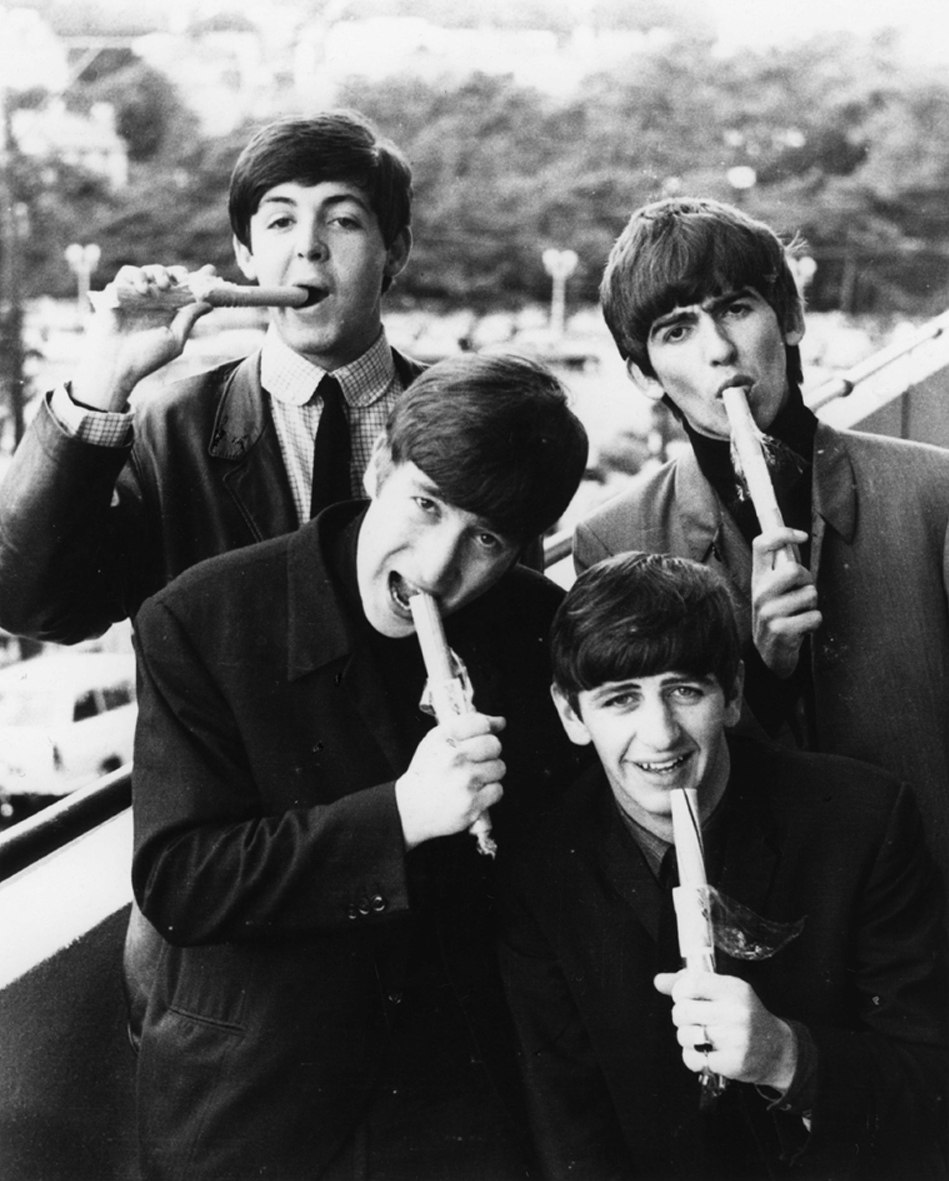
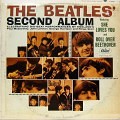

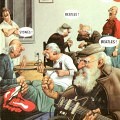
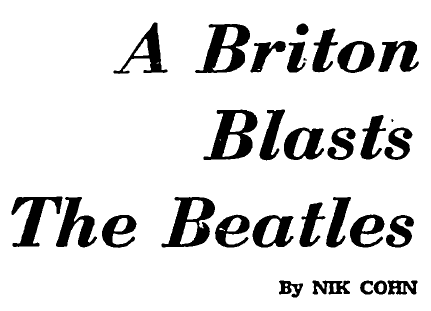

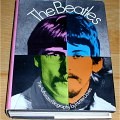



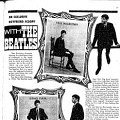
Devin, I’m still reading the book, and after your review I’m more motivated to finish it.
Unlike you, I was put off by McMillian’s refusal in the introduction to share his own preference for the Beatles or the Stones. To me to me it feels needlessly coy. I think that declaring his preference is “outside the purview of this book” is circular: he’s the one deciding what the book’s scope will be, after all. Absolute impartiality is impossible, and I prefer authors who lay their preferences on the table, so I better understand how to evaluate their arguments.
One of the fascinating things about the early part of the book is seeing how changeable the Stones were. The Beatles put on suits, but McMillian points out that the Stones altered their image twice — and, of course, they went through more changes in personnel.
Can you say more about how you see the Stones’ sinister persona as perhaps revealing “the deep male narcissism, often indulged by women, coiled at the center of that image”?
Nancy, I will be interested to know if you feel about the ending as I did.
Knowing McMillian’s preference wouldn’t have made it a better book for me; in fact it might have ruined it, by betraying the type of work he wanted to write. If he reveals his preference, the book becomes, de facto, not a historical narrative but a defense of that stated preference. And since we as readers and fans are coming in with our own preferences, our evaluation of his arguments (though I don’t find that McMillian is really making any) inevitably come down to, not how well he has written historical narrative, but how misguided or wise he is, depending on which side he chose. I respect McMillian’s decision to stay mum, imagining how badly he must have wanted to tip the scales by weighing in directly.
The comment about the Stones’ image springing from, and being dependent on, male narcissism is quite related to Mike’s comment about rock (read “rockist” in this discussion) critics and fans not liking Paul because he has girl-cooties. I meant it as a lead-in to the next paragraph, which pivots on Phil May’s observation of how boys gradually took over from girls as the dominant force in a certain type of rock crowd. Look at the Beatles’ audiences on film, or examine them in the world at large today, and they are about as sex-equal as you can find. Whereas the Stones’ audience, as noted, just got more and more male: the phenomenon of boys worshipping boys, men admiring each other.
The comment about women was influenced by McMillian’s quotation of a godawful Patti Smith poem about watching Jagger on the Ed Sullivan Show: I felt through his pants with optic x-ray. this was some hard meat. this was bitch, five white boys sexy as any spade. Enough–you get the point. For many women, not all of them doormats, the worship of cock is a big part of their fandom. Put another way, Jagger and the other great roosters of rock wouldn’t have become the “gods” they did without a large segment of the female fan-base being willing to serve as compliant groupies, either in fact or in their own fantasies. (The late Ellen Willis, a besotted Stones fan who as far as I can tell could take the Beatles or leave them, is the only woman I know to write about her own ambivalence as a feminist who finds a deep erotic thrill in the often misogynistic Stones.) This touches on issues of female desire, subjugation, and empowerment, not to mention uglier truths like rape fantasy, which Susan Brownmiller wrote about many years ago in Against Our Will–with, as I recall, some salient side words on the Stones and “Midnight Rambler.”
So I’m talking about Patti Smith, Ellen Willis, rocker chicks, biker chicks, feminists and doormats, all the women who play a role in maintaining the phallic side of the rock mythology. It may be, at its core, boys worshipping boys, but it wouldn’t exist without women to service it.
Thanks for expanding on that, Devin: I very much agree that the Stones are prototypical “cock rock.” And like you, I wish McMillian had explored more fully the implications of the Stones’ increasingly male audience and the Beatles’ mixed audience.
This book and your review have helped me articulate more fully why I’ve never felt too invested in the Stones, despite enjoying their late 60s through mid 70s albums: so often their music is about putting across a wised-up hardness that feels to me like a defensive pose. The Beatles, in contrast, were willing to put their ambivalence and vulnerability directly into their music. (Hence the “girl-cooties.”)
I thought some of the most illuminating parts of the book were the descriptions of Lennon and McCartney interacting with Jagger and Richards. John and Paul finishing the writing of “I Wanna Be Your Man” while Mick and Keith watched, and then coming into the studio and smartening up “We Love You” — that’s magic. And that dynamic sums up the whole “who’s greater?” question for me, to the extent that that question has meaning.
I also loved McMillian’s description of the furor surrounding “Revolution.” I’d known some left-wing critics hated it, but not the extent to which Lennon’s ambivalence toward violent political action was seen as a betrayal. Lennon’s willingness to enact his own uncertainty in that song has made it of much more lasting value than the unambiguous calls for revolution, in my opinion. In general, I think the Beatles leave more space for mixed feelings, for rethinking, for acknowledging the limits of understanding.
I did hate that McMillian ended the book with Lennon’s murder. It feels like an evasion of the work he had left to do as an historian, given the subject he chose. I think it’s irresponsible to spank the Stones for expensive tours and merchandising without talking about McCartney’s tours and the afterlife of Apple.
One last comment about McMillian’s stating that he won’t state his preference: to me it sets up a detective mission, with the reader trying to work out which band he prefers. Or maybe I just can’t help myself. In either case, I’ll eat my keyboard if he isn’t more of a Beatles than a Stones fan, given the book he produced.
Nancy: Actually, by comparison, the Stones should be “spanked” for their excessive ticket prices — much more so than McCartney. I just looked at the midyear concert earnings reported by Pollstar a week ago. The Stones average ticket price — AVERAGE — was $346. McCartney’s average ticket price: $129. (By comparison, Springsteen’s average was $107, and so was Fleetwood Mac’s.” So Paul is at least in the ballpark for “reasonable” ticket prices these days. The Stones are not.
And the Stones have released far more rehashed greatest hits albums than Apple. Of course that’s probably because the Beatles’ original albums are still selling fairly well, while the Stones original albums aren’t. The Stones are selling a lot more greatest-hits compilations than copies of their original albums.
This is an interesting post and discussion. This makes me want to read the book. There was another Stones v. Beatles book that came out 2 years ago, written by a couple of Chicago music critics. It was a nice coffee table book with lots of pictures but it was a VERY disappointing read, as one of the critics was bashing McCartney for all the usual superficial reasons (literally, one of the guy’s criticisms of Paul was that he had been sympathetic to parents in She’s Leaving Home). This writer was clearly a Stones fan who, conveniently, completely ignored the male narcissism issue you raise and/or the problematic rampant misogyny of the Stones’ lyrics. The whole book seemed like such an arrested-development, teenage-boy approach to music criticism — “like, wow, dude, the Stones were coool.”
So I hope this book is a more evenhanded, less fanboy read.
— Drew
i would love to join this discussion,but how can i when the book in question isn’t published for several months yet?
i am assuming advanced reader’s proofs are being used? or can the actualbook be found someplace?
thanks.
Drew, McMillian’s book is very, very different from the DeRogatis & Kot book. For those who haven’t read it, DeRogatis and Kot focused more closely on the music (with uneven results, in my opinion) and were laying out the arguments for judging which band was best in various areas (guitar, bass, drums, double albums, etc.). McMillian’s focus is on the history of how the bands were presented and how they interacted, both personally and on the level of the image (i.e., at first Oldham tried dressing the Stones like the Beatles, since the Beatles were getting big when the Stones were starting).
And yup, in much of their criticism DeRogatis and Kot typify the kind of “rockism” that Devin is talking about. In their Beatles/Stones book they make efforts to be more even-handed, and while that’s praiseworthy on one level, it also feels forced and unconvincing. Overall I found their book disappointing.
The irritating thing about McMillian’s book, to me, is that it doesn’t really go far enough. It ends way too abruptly and arbitrarily, and doesn’t go into enough depth on some of the more interesting points.
On Apple and McCartney’s tours, what I was trying to say is that it’s crazy McMillian doesn’t talk about either AT ALL at the end of the book. He just talks about the Stones.
Oh, and trawicki, yes, these are advance copies Devin and I are talking about. The book is being published at the end of October.
trawicki, publishers send review copies out months before a book hits the stands, on the presumption that critics need time to read the book and publications time to schedule a review. That’s usually how it works. Nancy and I just got to it a lot faster than others.
And Nancy, another reason I didn’t need McMillian to reveal his preference is that, like you, I had a clear sense throughout of what his preference was–even though I saw no giveaway lines or subtle pointers. Though the fact that he includes Hey Dullblog among the websites in his “Selected Bibliography”–without any Stones-fan equivalent–is a pretty good indication of where his sympathies lie.
Devin, by the time I got to the end of the book, I was in no doubt of McMillian’s preference, which made it all the odder that he made such a point of telling the reader he wasn’t going to tell us what it was. It’s one thing to say you’re not going to “adjudicate the question” of which band is best, and another to duck your own investment in the question by saying it’s beyond the self-determined scope of the book. Precisely because that investment can’t help but color the book, best just to state it.
But enough of that. McMillian threw new light on some key moments of Beatles and Stones history, and I learned things I didn’t know. So overall I thank him for writing it despite disagreeing with some of his authorial choices.
And I meant to say how much I agree with your point that many women uphold the macho rockist cult. I’d managed to forget that Patti Smith poem until you brought it up (gee, thanks) and wow is it a great illustration of that dynamic.
I don’t know how I feel about Dullblog actually informing historical commentary. Proud? Terrified? Equal measure.
I’m suddenly grateful for the occasional self-editing I do! 🙂
BTW, anybody who is interested in McMillian’s earlier overview of underground newspapers, Smoking Typewriters, here’s a video of his talk on CSPAN2’s “BookTV.” I watched it two weeks ago and enjoyed it.
http://youtu.be/pu8Umz16kNo